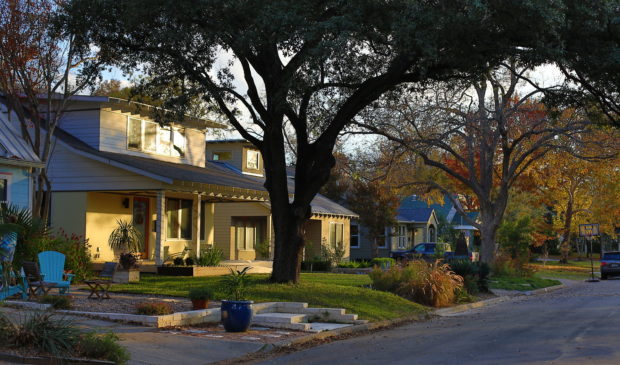Using neighborhood demographics might create deeply affordable housing. It might also be illegal.
Tuesday, March 15, 2022 by
Jonathan Lee As Austin’s housing affordability crisis deepens, public officials and advocates are looking for ways to create more income-restricted homes – especially those that are affordable to people at the lowest end of the income spectrum. One idea, floated by the Planning Commission on Tuesday, is changing how the city calculates a key metric of affordability: median family income.
Income restrictions for affordable homes are currently tied to the median family income of the Austin-Round Rock metropolitan statistical area, which in 2021 was $98,900 for a family of four. This means that only people making a certain percentage of the area MFI – usually anywhere from 30 to 80 percent, depending on the development – qualify to buy or rent affordable units. Commissioners wondered if using neighborhood MFI would be a better policy.
The idea is that pegging MFI to the neighborhood level would bring deeply affordable units to poorer neighborhoods, since the MFI in those areas is lower than the area MFI. Commissioner Carmen Llanes Pulido pointed out that using area MFI means affordable units in lower-income neighborhoods are not actually affordable for many current residents. “The so-called affordable units would also be gentrifying units,” Llanes Pulido said, explaining that the new units might bring higher-income people to the neighborhood.
While switching to neighborhood-level MFI sounds good in theory, in practice it might not be equitable or even legal, according to Erica Leak with the Housing and Planning Department. “(The policy) would actually be contrary to Affirmatively Furthering Fair Housing,” Leak said, referring to part of the 1968 Fair Housing Act which requires cities that receive federal housing funds to uphold and advance fair housing practices.
“Even though it’s intending to try and match the units with the neighborhood, which might be great in lower-income neighborhoods, it has an exclusionary effect in higher-income neighborhoods,” Leak said. “It basically keeps other members, potentially of protected classes, out of those neighborhoods.”
Unsurprisingly, the MFI varies greatly by neighborhood in Austin. Data from the 2015-2019 American Community Survey show that the MFI of Austin’s wealthiest census tract, which includes much of Tarrytown, is $234,432, while the MFI of Austin’s poorest census tract, which includes part of East Oltorf, is $28,219. While an income-restricted unit tied to East Oltorf’s MFI would be deeply affordable, a unit pegged to Tarrytown’s MFI would be out of reach for most.
This “exclusionary effect” could make the city vulnerable to a lawsuit. According to Leak, other cities that have enacted such a policy have been sued.
Llanes Pulido argued that the city would not have to apply neighborhood-level MFI across the whole city. Instead, affordable units in wealthy neighborhoods would still use area MFI, while affordable units in less wealthy parts of town would use neighborhood-level MFI. “That would be more equitable,” she said. While the legality of such a policy is still unclear, Leak said it’s something the city could look into.
The discussion Tuesday came during a briefing on proposed changes to the affordability requirements in the Vertical Mixed-Use density bonus program. Further VMU discussions at the Planning Commission are expected March 22. Though no commissioners proposed changing how the city determines MFI as part of an amended VMU program, the idea could still be a topic of further conversation as the city becomes less and less affordable.
“It seems like a worthy thing to challenge,” Llanes Pulido said.
Photo made available through a Creative Commons license.
The Austin Monitor’s work is made possible by donations from the community. Though our reporting covers donors from time to time, we are careful to keep business and editorial efforts separate while maintaining transparency. A complete list of donors is available here, and our code of ethics is explained here.
You're a community leader
And we’re honored you look to us for serious, in-depth news. You know a strong community needs local and dedicated watchdog reporting. We’re here for you and that won’t change. Now will you take the powerful next step and support our nonprofit news organization?











